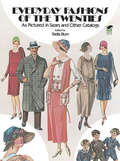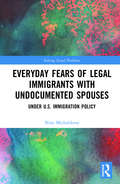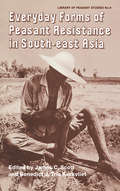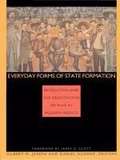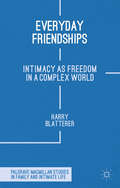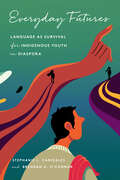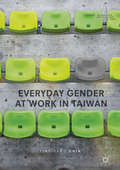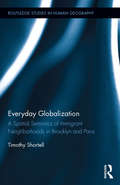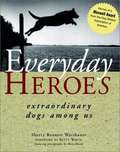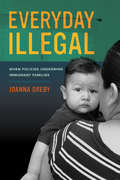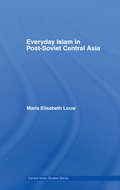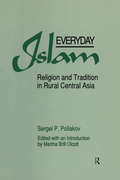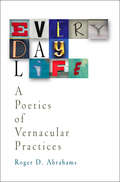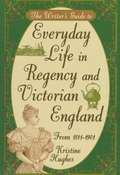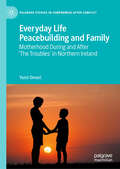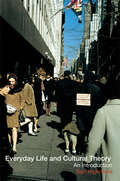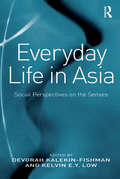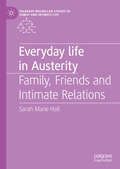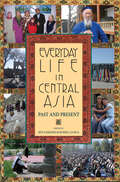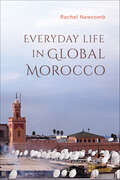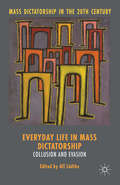- Table View
- List View
Everyday Fashions of the Thirties As Pictured in Sears Catalogs
by Stella BlumFor thousands of women across America, hard hit when the frivolity of the twenties ended so resoundingly with the Crash of '29, the pages of the Sears catalog became an essential resource in maintaining a wardrobe. An ambitious marketing operation, it could not afford to take chances on haute couture; its fashions were geared as closely as possible to the prevailing tastes of the American people. For this historically accurate sampling of authentic 1930s fashion, Stella Blum, former Curator of the Costume Institute at the Metropolitan Museum of Art in New York, selected for reproduction 133 representative pages from rare Sears catalogs of the period (fall and spring catalog for each year from 1930 to 1939). Hundreds of illustrations record what men, women, and children were actually wearing in the 1930s when, as a copyline from the Fall 1930 catalog proclaimed: "Thrift is the spirit of the day. Reckless spending is a thing of the past."You'll see here how simpler women's fashion designs -- of more traditional, affordable material -- recaptured the feminine form with a more natural waistline and lower hemlines than seen in the twenties. For evening wear, longer dresses replaced flamboyant beaded short gowns while cloche hats, another twenties trademark, were replaced by berets, pillboxes, and turbans. The seriousness of the accessories and dresses endorsed by such Hollywood legends as Loretta Young, Claudette Colbert, and Fay Wray.For historians of costume, nostalgia buffs and casual browsers, these pages afford a rare picture of how the average American really dressed during the thirties. It is an essential resource for study of the clothing of an important era which designers cannot afford to be without.
Everyday Fashions of the Twenties: As Pictured in Sears and Other Catalogs
by Stella BlumThe Roaring Twenties, age of jazz and flappers, Model T Fords and Hollywood movie stars, was also a time when for millions the bulky catalogs of Montgomery Ward or Sears, Roebuck were a substitute for the window displays of Paris or New York fashion shops. Buying clothing through the mails had become an American institution, and entire families were often dressed via the U.S. Post Office. More conservative than the up-to-the-minute fashion shops, mail-order catalogs nevertheless offered surprisingly much of the haute couture. But, above all, they accurately record what men, women, and children were actually wearing in the 1920s.Now Stella Blum (Curator of the Costume Institute at the Metropolitan Museum of Art, New York) has distilled into this volume the essence of the fashion pages of the Sears, Roebuck and other mail-order catalogs of the Twenties. Her informative text and selection of over 150 representative catalog pages -- comprising over 750 illustrations with original captions -- gradually trace the evolution of dress modes from the vogue of stodgy postwar fashions to the impact on costume of the crash of '29. In a year-by-year survey, Mrs. Blum's introductory texts relate the trends in fashion to the social changes of the dynamic and restless era, assessing the influence of war and technological developments on the high hemlines, flattened busts and hips, geometric patterns and "bobbed" hairstyles of the boyish flapper look. And as she notes, it was through the Sears catalogs that Parisian designers like Coco Chanel, Jeanne Lanvin, and Madeleine Vionnet made their influence felt on Midwestern farms and in urban ghettos.You'll find here a marvelous panorama of "smart," "modish," "chic," "stylish," and "ultra fashionable" apparel, as well as more traditional garments: for women and "misses" there are Middy blouses, Russian boots modeled by Gloria Swanson, "Bob" hats modeled by Clara Bow and Joan Crawford; coats, suits, dresses (including the first maternity dresses), sweaters, capes; silk and rayon stockings, corsets, chemises, camisoles, negligees; and accessories like necklaces, belts, combs, headbands, umbrellas, gloves, compacts, hand bags, wristwatches, and powderpuff cases. You'll see slower-to-change men's fashions -- shirts, ties, suits, sweaters, and sports clothes -- become trimmer, brighter, smarter. And you can follow the trends in children's fashions as well.For historians of costume, nostalgia buffs, and casual browsers, these pages afford a rare picture -- unspoiled by recent myths about the Roaring Twenties -- of how average people really dressed in the jazz age.
Everyday Fears of Legal Immigrants with Undocumented Spouses: Under U.S. Immigration Policy (Solving Social Problems)
by Nina MichalikovaThis book examines the adaptation experiences of legal immigrants with undocumented spouses, considering the structural limitations that they face in their private, social, and professional lives, as well as in regard to their finances and health. The first study to systematically analyze the ways in which legal immigrants are affected by federal and state policies that target their undocumented spouses, it reveals that, regardless of their immigration status, all members of mixed-status families are directly or indirectly subjected to the same intrusive and punitive laws. Based on an autoethnographic approach, Everyday Fears of Legal Immigrants with Undocumented Spouses: Under U.S. Immigration Policy also draws on additional qualitative research as well empirical evidence from existing studies and the latest quantitative data from various governmental agencies and think tanks. It thus integrates multiple approaches to ways of knowing and understanding the experiences of legal immigrants in mixed-status families and will therefore appeal to social scientists with interests in migration.
Everyday Forms of Peasant Resistance in South-East Asia: Everyday Forms Res Asia
by James C. Scott and Benedict J. Tria KerkvlietFirst published in 1987. Routledge is an imprint of Taylor & Francis, an informa company.
Everyday Forms of State Formation: Revolution and the Negotiation of Rule in Modern Mexico
by Gilbert M. Joseph Daniel NugentEveryday Forms of State Formation is the first book to systematically examine the relationship between popular cultures and state formation in revolutionary and post-revolutionary Mexico. While most accounts have emphasized either the role of peasants and peasant rebellions or that of state formation in Mexico's past, these original essays reveal the state's day-to-day engagement with grassroots society by examining popular cultures and forms of the state simultaneously and in relation to one another.Structured in the form of a dialogue between a distinguished array of Mexicanists and comparative social theorists, this volume boldly reassesses past analyses of the Mexican revolution and suggests new directions for future study. Showcasing a wealth of original archival and ethnographic research, this collection provides a new and deeper understanding of Mexico's revolutionary experience. It also speaks more broadly to a problem of extraordinary contemporary relevance: the manner in which local societies and self-proclaimed "revolutionary" states are articulated historically. The result is a unique collection bridging social history, anthropology, historical sociology, and cultural studies in its formulation of new approaches for rethinking the multifaceted relationship between power, culture, and resistance.Contributors. Ana María Alonso, Armando Bartra, Marjorie Becker, Barry Carr, Philip Corrigan, Romana Falcón, Gilbert M. Joseph, Alan Knight, Florencia E. Mallon, Daniel Nugent, Elsie Rockwell, William Roseberry, Jan Rus, Derek Sayer, James C. Scott
Everyday Friendships: Intimacy as Freedom in a Complex World (Palgrave Macmillan Studies in Family and Intimate Life)
by H. BlattererThis book conceptualises the lived experience of intimacy in a world in which the terms and conditions of love and friendship are increasingly unclear. It shows that the analysis of the 'small world' of dyads can give important clues about society and its gendered makeup.
Everyday Futures: Language as Survival for Indigenous Youth in Diaspora
by Stephanie Canizales Brendan O'ConnorDespite increasing attention on unaccompanied Central American youth migration to the United States, little empirical research has examined the crucial role of language in the incorporation process, particularly for Indigenous youth. Drawing on the perspectives of Maya (primarily K'iche')-speaking Guatemalan youth, Everyday Futures explores their experiences of language socialization in the broader Los Angeles immigrant community. Stephanie L. Canizales and Brendan H. O'Connor trace the factors that were most important to their quest for well-being and belonging across Guatemalan and American societies. Coming from contexts where Maya languages were stigmatized, these youth's migration journeys and early years after arrival were characterized by what they called "preparation" and "adaptation," processes through which they actively sought the linguistic and social expertise needed to promote their long-term survival in the US. While many faced struggles, some were able to achieve social and economic mobility, which instilled in them a sensibility of survival that enabled them to advocate for more recently arrived Maya youth and the maintenance of Maya language and culture. This book sheds important light on the dynamic process of "future-making" for Indigenous youth and yields rich insights into the role of language in creating hope in the diaspora.
Everyday Gender at Work in Taiwan (Gender, Sexualities and Culture in Asia)
by Ting-Fang ChinThis book explores professional women’s experiences of gender in the Taiwanese workplace in the wake of the rapid transformation of the country's economy, identifying attitudes to gender in a heterosexist and heteronormative social culture. It contributes to understanding women’s relationships with their superiors and peers at work and the strategies that they have used to negotiate with these role partners to achieve their own personal and career goals. It notes that compared to women in other East Asian economies, women in Taiwan have a more consistent career trajectory and that the local women’s movement and activism has brought Taiwan a long way in improving women’s employment rights, but argues that it is too soon to claim that gender inequality has been banished from the workplace. Based on qualitative, in-depth interviews, the book explores the participants’ accounts, gendered and heteronormative practices at work, in two contexts: organisational management and everyday social encounters. It investigates gender inequality at work by focusing on women employees’ everyday experiences, and examines structural and institutional factors affecting gendered arrangements, as well as personal experiences in negotiating gender. A key read for students and scholars in gender and employment studies, this book will also be of interest to those working within the field of employment sociology and organisational culture.
Everyday Globalization: A Spatial Semiotics of Immigrant Neighborhoods in Brooklyn and Paris (Routledge Studies in Human Geography #60)
by Timothy ShortellEveryday Globalization is a micro-sociological study of immigrant neighborhoods in Brooklyn and Paris. Global flows of people bring together cultural practices from distant places and urban dwellers in global cities interpret the signs of collective identity in ascribing particular places as "immigrant neighborhoods." This book examines the spatial semiotics of identity in urban public space that make this possible. Unlike other studies of globalization and cities, this work brings together research on the social psychology of groups, linguistic landscapes, and quotidian mobility to explain how urban dwellers encounter cultural differences. Signs of social identity are always interpreted in the context of group boundaries and the appropriation of public space. The breadth of this analysis contributes to the literature in human geography on the meaningfulness of places. This book will also be of interest to scholars and students in visual sociology. In addition, this research demonstrates an innovative method for studying everyday urban experience.
Everyday Heroes: Extraordinary Dogs Among Us
by Sherry Bennett WarshauerTells the stories of dogs who detect narcotics, identify seizures, solve crime and and much more.
Everyday Illegal
by Joanna DrebyWhat does it mean to be an illegal immigrant, or the child of immigrants, in this era of restrictive immigration laws in the United States? As lawmakers and others struggle to respond to the changing landscape of immigration, the effects of policies on people's daily lives are all too often overlooked. In Everyday Illegal, award-winning author Joanna Dreby recounts the stories of children and parents in eighty-one families to show what happens when a restrictive immigration system emphasizes deportation over legalization. Interweaving her own experiences, Dreby illustrates how bitter strains can arise in relationships when spouses have different legal status. She introduces us to "suddenly single mothers" who struggle to place food on the table and pay rent after their husbands have been deported. Taking us into the homes and schools of children living in increasingly vulnerable circumstances, she presents families that are divided internally, with some children having legal status while their siblings are undocumented. Even children who are U.S. citizens regularly associate immigration with illegality. With vivid ethnographic details and a striking narrative, Everyday Illegal forces us to confront the devastating impacts of our immigration policies as seen through the eyes of children and their families. As legal status influences identity formation, alters the division of power within families, and affects the opportunities children have outside the home, it becomes a growing source of inequality that ultimately touches us all.
Everyday Irrationality: How Pseudo- Scientists, Lunatics, And The Rest Of Us Systematically Fail To Think Rationally
by Robyn DawesRobyn Dawes defines irrationality as adhering to beliefs that are inherently self-contradictory, not just incorrect, self-defeating, or the basis of poor decisions. Such beliefs are unfortunately common. Witness two examples: the belief that child sexual abuse can be diagnosed by observing symptoms typically resulting from such abuse, rather than symptoms that differentiate between abused and non-abused children; and the belief that a physical or personal disaster can be understood by studying it alone in-depth rather than by comparing the situation in which it occurred to similar situations where nothing bad happened. This book first demonstrates how such irrationality results from ignoring obvious comparisons. Such neglect is traced to associational and story-based thinking, while true rational judgment requires comparative thinking. Strong emotion--or even insanity--is one reason for making automatic associations without comparison, but as the author demonstrates, a lot of everyday judgment, unsupported professional claims, and even social policy is based on the same kind of irrationality.
Everyday Islam in Post-Soviet Central Asia (Central Asian Studies #Vol. 7)
by Maria Elisabeth LouwProviding a wealth of empirical research on the everyday practise of Islam in post-Soviet Central Asia, this book gives a detailed account of how Islam is understood and practised among ordinary Muslims in the region, focusing in particular on Uzbekistan. It shows how individuals negotiate understandings of Islam as an important marker for identity, grounding for morality and as a tool for everyday problem-solving in the economically harsh, socially insecure and politically tense atmosphere of present-day Uzbekistan. Presenting a detailed case-study of the city of Bukhara that focuses upon the local forms of Sufism and saint veneration, the book shows how Islam facilitates the pursuit of more modest goals of agency and belonging, as opposed to the utopian illusions of fundamentalist Muslim doctrines.
Everyday Islam: Religion and Tradition in Rural Central Asia
by Martha Brill Olcott Sergei P. PoliakovWith a rapidly growing population, deteriorating economic and environmental conditions, and an unstable imperial centre, Soviet Central Asia would seem destined to become one of the world's trouble spots. Why then the apparent political quiet? This book argues that this perception is, in itself, a reflection of our ignorance of the region. Instead, argues the author, Islamic traditionalism has not only survived but has flourished and is resurgent in Central Asia. This book includes chapters on marital customs, the care of children, communal decision making, social prestige and values, and the "second" economy in Central Asia. Poliakov demonstrates the resilience of an "un-Soviet" way of life which is supported by underground institutions, fostered by "unofficial" clergy, and protected by the infiltration and subordination of government and party organs.
Everyday Knowledge And Uncommon Truths: Women Of The Academy
by Linda Christian-smithEveryday Knowledge and Uncommon Truths: Women of the Academy is a thirteen chapter volume which draws on the life experience and varied backgrounds of academic women from the United States, Australia, New Zealand, and Canada. The book addresses a variety of issues pertaining to women’s home lives, education, teaching, research, writing, and activism. To provide diverse perspectives on women’s experiences of being and knowing in and outside the academy, contributors draw on a range of critical approaches derived from feminism, poststructuralism, postmodernism, critical education theory, discourse theory and analysis, narrative inquiry and life histories. Lately, there has been considerable interest by women in the academy in a discernment process involving an examination of the historically, politically and culturally situated nature of their knowledge of the world, their work in the academy and other activities in which they engage. These examinations, especially in the form of narrative inquiry, life histories and deconstructive language practices such as discourse analysis, figure prominently in breaking silences and giving voice to the many tensions that women experience in the academic workplace and other settings.
Everyday Life
by Roger D. AbrahamsA folklorist and ethnographer who has written about the Southern Appalachians, African American communities in the United States, and the West Indies, Roger D. Abrahams goes up against the triviality barrier. Here he takes on the systematics of his own culture. He traces forms of mundane experience and the substrate of mutual understandings carried around as part of our own cultural longings and belongings.Everyday Life explores the entire range of social gatherings, from chance encounters and casual conversations to well-rehearsed performances in theaters and stadiums. Abrahams ties the everyday to those more intense experiences of playful celebration and serious power displays and shows how these seemingly disparate entities are cut from the same cloth of human communication.Abrahams explores the core components of everyday-ness, including aspects of sociability and goodwill, from jokes and stories to elaborate networks of organization, both formal and informal, in the workplace. He analyzes how the past enters our present through common experiences and attitudes, through our shared practices and their underlying values.Everyday Life begins with the vernacular terms for "old talk" and offers an overview of the range of practices thought of as customary or traditional. Chapters are concerned directly with the terms for intense experiences, mostly forms of play and celebration but extending to riots and other forms of social and political resistance. Finally Abrahams addresses key terms that have recently come front and center in sociological discussions of culture in a global perspective, such as identity, ethnicity, creolization, and diaspora, thus taking on academic jargon words as they are introduced into vernacular discussions.
Everyday Life In Regency And Victorian England (The Writer's Guide To Everyday Life Ser.writer's Guide To Everyday Life Series)
by Kristine HughesIn this timesaving reference book, respected author and historian Kristine Hughes brings 19th century England to life as she leads you through the details that characterize this fascinating era. From slice-of-life facts, anecdotes and firsthand accounts, to sweeping timelines and major historical events, this guide presents the delightful and often surprising daily realities of Regency and Victorian England. With it, you'll craft a vibrant story as you learn what people ate, from pigeon pie and turtle dinners to syllabub and milk punch, where a prisoner would go if he were remanded to the "hulks; " the four coats a gentleman must have in his wardrobe, and other fashion requirements of the era; the rules honored by decent society, from the proper way to promenade to the polite hours to "call; " how couples married and divorced, through churching, wife-selling and other practices; what people did for work, from cottagers and climbing boys to milkmaids and manservants; the meaning of common slang words like mawleys and moleskins; what Cook's Tours were life and where they could take the adventurous; and trends in entertainment, such as dandies, panoramas and more.
Everyday Life Peacebuilding and Family: Motherhood During and After 'The Troubles' in Northern Ireland (Palgrave Studies in Compromise after Conflict)
by Yumi OmoriThis book offers a novel approach to studying war and peace by foregrounding motherhood in times of conflict and peace processes from a sociological perspective. Through qualitative research resting on individual and focus group interviews with 55 mothers who had lived through the Northern Ireland conflict, this book examines the gendered nature of coping with conflict and its aftermath in peace processes. Drawing on the idea of everyday life peacebuilding, it discusses how the family is located in the processes of social transformation in conflict-affected societies, and illuminates that mothers play central yet largely unnoticed roles in maintaining and restoring sociability in a conflict-affected society. The book illustrates that mothers have been hidden and underappreciated ‘everyday peacebuilders’, as well as hidden and trivialised victims of the conflict.
Everyday Life and Cultural Theory: An Introduction
by Ben HighmoreEveryday Life and Cultural Theory provides a unique critical and historical introduction to theories of everyday life. Ben Highmore traces the development of conceptions of everyday life, from the cultural sociology of Georg Simmel, through the Mass-Observation project of the 1930s to contemporary theorists such as Michel de Certeau.
Everyday Life in Asia: Social Perspectives on the Senses
by Devorah Kalekin-FishmanEveryday Life in Asia offers a range of detailed case studies which present social perspectives on sensory experiences in Asia. Thematically organized around the notions of the experience of space and place, tradition and the senses, cross-border sensory experiences, and habitus and the senses - its rich empirical content reveals people's commitment to place, and the manner in which its sensory experience provides the key to penetrating the meanings abound in everyday life. Offering the first close analysis of various facets of sensory experience in places that share a geographical location or cultural orientation in Asia, this collection links the conception of place with understandings of 'how the senses work'. With contributions from an international team of experts, Everyday Life in Asia will be of interest to anthropologists, geographers and sociologists with interests in culture, everyday life, and their relation to the senses of place and space.
Everyday Life in Austerity: Family, Friends and Intimate Relations (Palgrave Macmillan Studies in Family and Intimate Life)
by Sarah Marie HallThis book is about the impact of austerity in and on everyday life, based on a two-year ethnography with families and communities in ‘Argleton’, Greater Manchester, UK. Focused on family, friends and intimate relations, and their intersections, the book develops a relational approach to everyday austerity. It reveals how austerity is a deeply personal and social condition, with impacts that spread across and between everyday relationships, spaces and temporal perspectives. It demonstrates how austerity is lived and felt on the ground, with distinctly uneven socio-economic consequences. Furthermore, everyday relationships are subject to change and continuity in times of austerity. Austerity also has lasting impacts on personal and shared experiences, both in terms of day-to-day practices and the lifecourses people imagine themselves living.
Everyday Life in Central Asia: Past and Present
by Jeff Sahadeo and Russell ZancaThis illuminating anthology provides a range of perspectives on daily life across Central Asia and how it has changed in the post-Soviet era.For its citizens, contemporary Central Asia is a land of great promise and peril. While the end of Soviet rule has opened new opportunities for social mobility and cultural expression, political and economic dynamics have also imposed severe hardships. In this lively volume, contributors from a variety of disciplines examine how ordinary Central Asians lead their lives and navigate shifting historical and political trends.Provocative stories of Turkmen nomads, Afghan villagers, Kazakh scientists, Kyrgyz border guards, a Tajik strongman, guardians of religious shrines in Uzbekistan, and other narratives illuminate important issues of gender, religion, power, culture, and wealth. A vibrant and dynamic world of life in urban neighborhoods and small villages, at weddings and celebrations, at classroom tables, and around dinner tables emerges from this introduction to a geopolitically strategic and culturally fascinating region.
Everyday Life in Global Morocco (Public Cultures Of The Middle East And North Africa Ser.)
by Rachel NewcombFollowing the story of one middle class family as they work, eat, love, and grow, Everyday Life in Global Morocco provides a moving and engaging exploration of how world issues impact lives. Rachel Newcomb shows how larger issues like gentrification, changing diets, and nontraditional approaches to marriage and fertility are changing what the everyday looks and feels like in Morocco. Newcomb's close engagement with the Benjelloun family presents a broad range of responses to the multifaceted effects of globalization. The lived experience of the modern family is placed in contrast with the traditional expectation of how this family should operate. This juxtaposition encourages new ways of thinking about how modern the notion of globalization really is.
Everyday Life in Mass Dictatorship: Collusion and Evasion (Mass Dictatorship in the Twentieth Century)
by Alf L�dtkeOppression and violence are often cited as the pivotal aspects of modern dictatorships, but it is the collusion of large majorities that enable these regimes to function. The desire for a better life and a powerful national, if not imperial community provide the basis for the many forms of people's cooperation explored in this volume.

